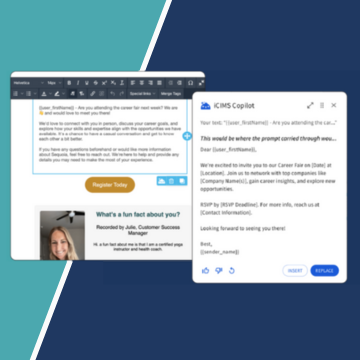- Solutions
- Products
- Community
- Resources
- Company
Create incredible candidate experiences that communicate your brand, mission, and values with recruitment marketing solutions.
Learn moreCommunicate effectively and efficiently with the candidates that can drive your business forward.
Learn moreSelect the right candidates to drive your business forward and simplify how you build winning, diverse teams.
Learn moreHelp your best internal talent connect to better opportunities and see new potential across your entire organization.
Learn moreCommunicate collectively with large groups of candidates and effectively tackle surges in hiring capacity.
Learn moreAccess tools that help your team create a more inclusive culture and propel your DEI program forward.
Learn moreRebound and respond to the new normal of retail with hiring systems that are agile enough to help you forge ahead.
Learn moreAccelerate the hiring of key talent to deliver point of care and support services that meet and exceed your promise of patient satisfaction.
Learn moreAttract and engage candidates with technical competencies, accelerate hiring for much-needed skills, and advance expertise within your valued workforce.
Learn moreSimplify how you recruit finance, insurance, and banking candidates with a unified platform built to match top talent with hard-to-fill roles.
Learn moreYour business strategy depends on your people strategy. Keep both in lockstep with the iCIMS Talent Cloud.
Learn moreBuild an engaging, high-converting talent pipeline that moves your business forward.
Learn moreDeliver the innovation your talent team needs, along with the global scale and security you demand.
Learn moreDeliver tailored technology experiences that delight users and power your talent transformation with the iCIMS Talent Cloud.
Learn moreThe #1 ATS in market share, our cloud-based recruiting software is built for both commercial and large, global employers.
Learn more Talk to salesAttract the best talent for your business with powerful, on-brand career websites that excite candidates and drive engagement.
Learn more Talk to salesCombine behavior-based marketing automation with AI insights to build talent pipelines, engage candidates with multi-channel marketing campaigns, and automatically surface the right talent for the job.
Learn more Talk to salesEmpower candidates with automated self-service, qualification screening, and interview scheduling through an AI-enabled digital assistant.
Learn more Talk to salesSimplify employee onboarding with automated processes that maximize engagement and accelerate productivity.
Learn more Talk to salesVerify skills with game-changing levels of automation and simplicity to improve the quality of hire at scale.
Learn more Talk to salesModernize, streamline, and accelerate your communication with candidates and employees.
Learn more Talk to salesTransform the talent experience by showcasing your authentic employer brand through employee-generated video testimonials.
Learn more Talk to salesSimplify recruiting, dynamically engage talent, and reduce hiring bias with job matching and recruiting chatbot technology.
Learn moreStreamline and centralize your HR tech stack with configurable, flexible, secure and reliable integrations.
Learn moreHow a beloved restaurant hires 40,000+ annually with a great candidate experience.
Learn moreThousands strong, our global community of talent professionals includes creatives, innovators, visionaries, and experts.
Learn moreTogether we’re creating the world’s largest ecosystem of integrated recruiting technologies.
Learn morePartner with our global professional services team to develop a winning strategy, build your team and manage change.
Learn moreExplore our network of more than 300 certified, trusted third-party service and advisory partners.
Learn moreUncover unique market insights, explore best practices and gain access to talent experts across out library of content.
Get resourcesExpert guidance about recruitment solutions, changes in the industry, and the future of talent.
Learn moreStay up to date with the latest terminology and verbiage in the HR software ecosystem.
Learn moreEmployers everywhere improve hiring efficiently and save money using iCIMS. Estimate the potential business value you can achieve.
Learn moreDive into the Class of 2023 Report highlighting this cohort’s expectations and where employers are willing — and able — to meet them.
Watch nowPartner with iCIMS to build the right strategies, processes, and experience to build a winning workforce.
Learn moreExpert guidance about recruitment solutions, changes in the industry, and the future of talent.
Learn moreDeliver the innovation your talent team needs, along with the global scale and security you demand.
Learn moreView press releases, media coverage, and the latest hiring data. See what analysts are saying about iCIMS.
Learn moreiCIMS is the Talent Cloud company that empowers organizations to attract, engage, hire, and advance the talent that builds a winning workforce.
Learn moreGet to know the award-winning leadership team shaping the future of the recruiting software industry.
Learn moreWe believe the future of work isn't something that "happens" to you. It's something you create. We actively create the future of work with our customers every day.
Learn moreiCIMS is committed to being a responsible and ethical corporate citizen, which is why Environmental, Social and Governance (ESG) initiatives are strategic imperatives.
Learn moreStreamline your tech stack and take advantage of a better user experience and stronger data governance with ADP and the iCIMS Talent Cloud.
Learn moreThe combined power of iCIMS and Infor helps organizations strategically align their business and talent objectives.
Learn moreOur award-winning partnership with Microsoft is grounded in a shared desire to transform the workplace and the hiring team experience.
Learn moreOur partnership with Ultimate Kronos Group (UKG) supports the entire talent lifecycle by bringing frictionless recruiting solutions to UKG Pro Onboarding.
Learn moreLet’s get in touch. Reach out to learn more about iCIMS products and services.
Learn more

Key Points:
Recruiting has advanced past the days of desktop computers. Mobile phones now play an increasing role in all aspects of recruiting, including sourcing, applications, screening, and onboarding.
Here are four ways to elevate your TA strategy with mobile recruiting software:
Hard Rock uses text-to-apply campaigns to source candidates. Their mobile recruiting strategy works like this: during their stay, a potential job seeker runs across a poster or some other physical advertisement for a job. Job seekers then text a code word – in Hard Rock’s case it’s ICONIC – to 97211.


Job seekers are then guided through a quick and straightforward application process, and just like that, they’re in your system and under consideration. An automated recruiting assistant handles this part, providing 24/7 coverage. Job seekers can interact with your brand day and night, weekday or weekend – all without ever sitting down to apply at a desktop.
This mobile recruiting strategy capitalizes on the good feelings of the customer experience. It says to candidates, “Hey, if you’re having a fun time, imagine working here.”
You can read more about how Hard Rock uses mobile recruiting software to source candidates.
Allan Myer’s mobile recruiting software helped them grow their talent pools by 10x. Like many employers, the civil construction firm’s typical candidate doesn’t sit behind a desk. Instead, they’re out on the job site. Mobile recruiting software gives their recruiters an edge; they’re able to engage, screen, and schedule interviews with candidates through text messages.
Candidates who aren’t ready to apply are added to Allan Myer’s talent pipeline, which they’ve grown by 15x since implementing their mobile recruiting strategy.
Read the rest of Allan Myer’s recruitment success story.
Mobile job seekers complete 53% fewer applications and take 80% longer to complete applications than their peers on desktop computers. Despite this, well over half of job seekers in many industries – retail, healthcare, and manufacturing to name a few – search for jobs on their mobile devices.
In other words, most candidates find you on mobile, but wait to apply until they’re at a desktop. This creates a huge drop-off risk. Picture this: a candidate finds you while scrolling through their phone during their morning commute. They click through to the application, but it’s clear right away it’ll take too long. They make a mental note to apply that evening. One thing leads to another and the opportunity passes.
It’s vital that your mobile recruiting software keeps up with the realities of everyday life. Your application process should be quick and easy to complete on a mobile device.But don’t just do it – tell people about it. Job seekers will only know how easy or difficult your mobile recruiting software is in retrospect. Simply telling candidates up front that your hiring process is mobile-friendly can increase the number of applications you get by 11.6%.
A good mobile recruiting strategy doesn’t just attract candidates, it protects your investment in them. Employers spend an average of $680 a day per vacant role. Losing them before their first day of work isn’t just a lost opportunity; it impacts your bottom line.
While it’s common practice in the U.S. and U.K. to give two weeks’ notice before leaving a job, this custom varies by industry and geography. In much of Europe, the custom is longer, and in some places, 1–2 months is required by law. Keeping candidates engaged through that period of transition can be a challenge.
The modern phenomenon of “ghosting” an employer is a particularly high risk for amusement park operator Cedar Fair, as the company typically hires seasonal workers months in advance of a park’s opening. Cedar Fair’s recruiters tackle this risk by monitoring who is and isn’t responding to emails. Recruiters then follow-up via text with new hires they’re worried won’t show up for their first day of work in an effort to reengage them.
Discover more about how Cedar Fair keeps new hires engaged before their first day.
Learn more about how mobile recruiting software can benefit your business with the iCIMS talent acquisition software.




